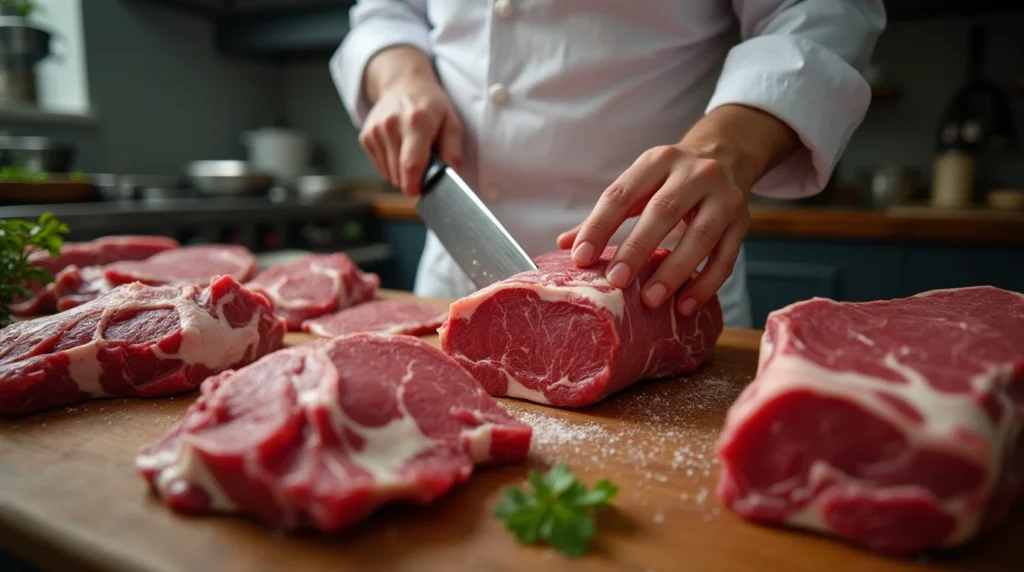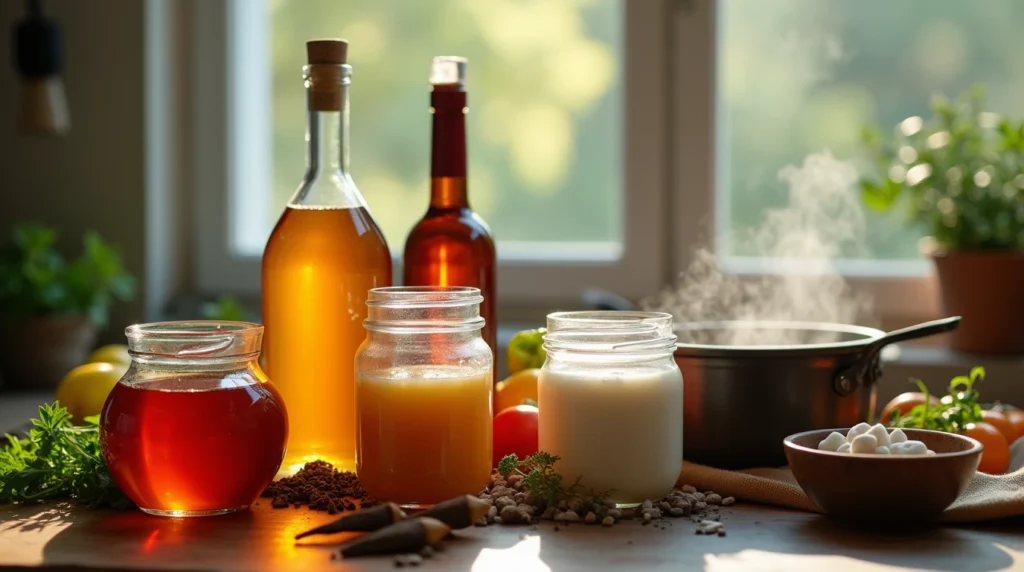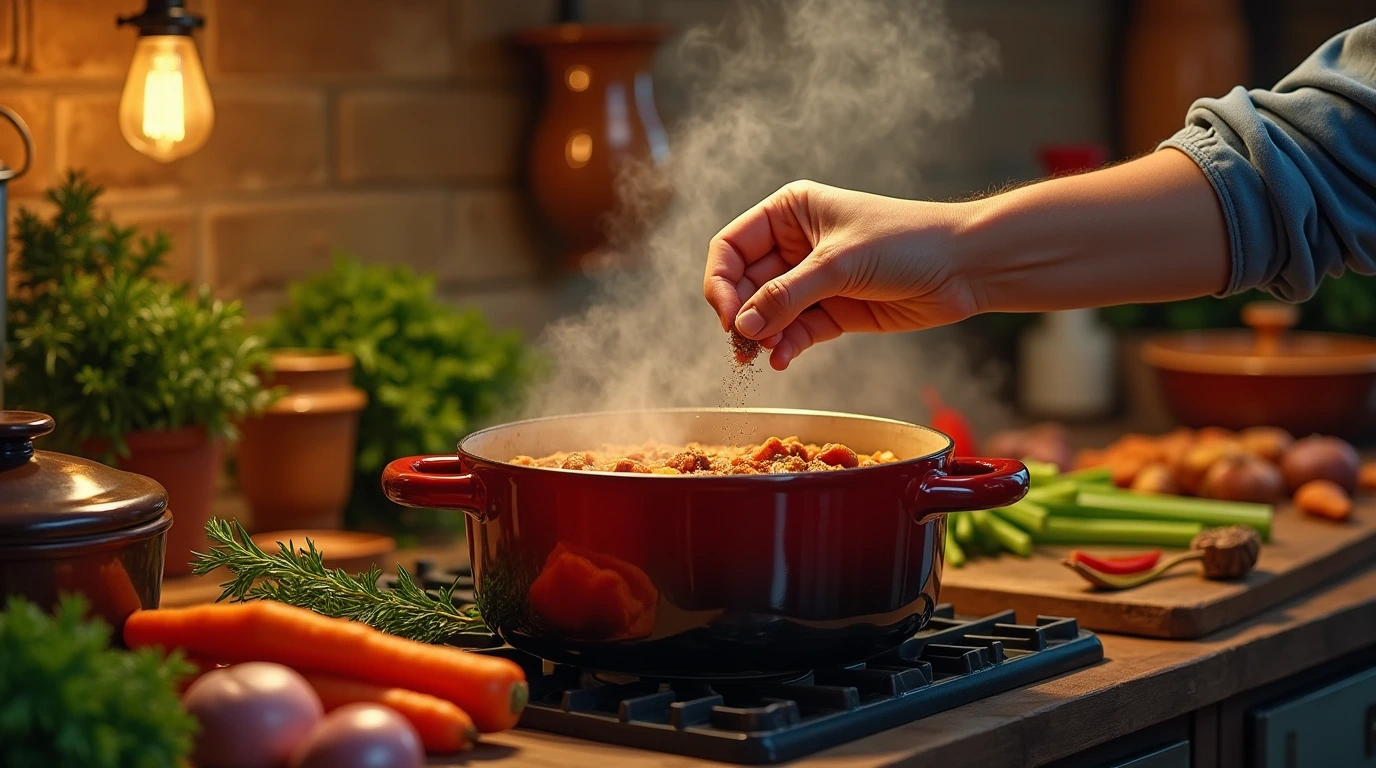Making the perfect stew is a fun journey in the kitchen. But, it’s key to know what not to add to avoid mistakes. A great stew has the right mix of flavors and textures, making it a cozy treat. To get it right, choose your ingredients carefully, learn the best cooking methods, and add things at the right time.
Using the right meat, like chuck, makes it tender. Avoiding lean meats like sirloin helps prevent toughness. It’s also important to know when to add vegetables. Some veggies need more time to cook, while others might get mushy if added too early. Paying attention to these details will help you make a stew that impresses everyone.
The Importance of Choosing the Right Cut of Meat
Choosing the right meat for stew is key to a delicious dish. The right cuts add flavor and texture. Chuck meat is a top choice because it breaks down well during long cooking.
This section explains why chuck is great and which lean cuts to avoid for the best stew.

Why Chuck is the Best Choice
Chuck meat comes from the cow’s shoulder. It’s made of different muscles, giving it a mix of textures and tastes. As it cooks, the meat becomes tender and rich.
Cuts like beef shank and neck are also good because they have lots of connective tissue. They take longer to cook but end up tender and full of flavor.
Avoid Lean Cuts Like Sirloin
Lean cuts like sirloin might seem good for stew, but they’re not. They become dry and chewy when cooked for a long time. It’s better to choose cuts with more fat and connective tissue.
Fatty cuts are tasty, but too much fat can make the stew less good. Knowing which lean cuts to avoid is important for a great stew.
| Cut of Meat | Cooking Characteristics | Texture | Recommended for Stew |
|---|---|---|---|
| Beef Chuck | Medium-fat, short cooking time | Tender and flavorful | Yes |
| Beef Shank | High connective tissue, longer cooking time | Very tender | Yes |
| Sirloin | Low fat, quick cooking | Dry and chewy | No |
| Brisket | Fatty and lean parts, medium cooking time | Juicy, varied | Yes |
| Oxtail | High fat, long cooking time | Rich and gelatinous | Yes |
What Not to Put in a Stew? Common Mistakes
Making a great stew is more than just mixing ingredients. Knowing what not to add is key. This ensures your stew tastes good and your veggies stay crunchy.
Understanding Ingredients That Can Ruin Flavor
Using the wrong ingredients can mess up your stew. Water is okay, but beef stock or broth make it taste better. Choose beef chuck for tender meat, not sirloin.
Adding wine or vinegar at the end is smart. It boosts flavor without overpowering the stew.
Identification of Mushy Vegetables
Timing is everything when adding veggies to your stew. Potatoes and carrots should go in 20 minutes before it’s done. This prevents them from getting mushy.
Other veggies should be added with about 45 minutes of cooking left. This keeps them firm and flavorful. Knowing these times makes your stew better.
The Art of Searing Meat for Flavor
Searing meat for stew is key to adding rich flavors and a great texture. This method creates a perfect brown crust that makes the dish better. To get that flavor right, you need to follow some important steps.
How to Achieve Perfect Browning
Choosing the right cuts is the first step for perfect browning. Ribeye, strip steak, filet mignon, and chuck roast work well. Season the meat with a 4:1 salt-to-pepper ratio before cooking.
Cook at high heat for 3-5 minutes on each side. This ensures the meat is cooked to your liking. After searing, let the meat rest for 5-10 minutes. This makes the meat juicy and flavorful.
Benefits of Searing vs. Steaming Meat
Searing beats steaming in terms of flavor and color. Steaming makes meat pale and lacks flavor. Searing caramelizes the meat, creating deep flavors and a nice color.
The fond from searing is great for making pan sauces. These sauces add even more flavor to your stew. After deglazing, simmer the liquid for 5 minutes to reduce it. This mixes the flavors into the stew.
| Meat Type | Cooking Time (minutes) | Ideal Temperature (°F) |
|---|---|---|
| Ribeye | 3-5 | Medium-rare (125°F) |
| Chuck Roast | 3-5 | Medium (135°F) |
| Filet Mignon | 3-5 | Medium-rare (125°F) |
| Flank Steak | 3-5 | Medium (135°F) |
| Boneless Pork Chops | 3-5 | 150°F |
Timing Your Vegetables Correctly
Adding vegetables to your stew at the right time can really make a difference. Knowing how to cook different vegetables helps you get the best taste and texture. It’s all about adding each vegetable at the right moment to keep their flavor and texture.
Hearty Vegetables vs. Delicate Vegetables
Carrots and potatoes are great because they can cook for a long time. They soak up flavors and stay firm. On the other hand, peas and spinach cook fast and can lose their color if cooked too long.
When to Add Each Type for Best Texture
Start with the hearty vegetables like carrots and potatoes. They cook slowly and soak up all the flavors. Then, add the delicate ones like peas and spinach towards the end. This way, they stay fresh and vibrant.
| Vegetable Type | Examples | Ideal Cooking Time |
|---|---|---|
| Hearty Vegetables | Carrots, Potatoes, Turnips | 30-60 minutes |
| Delicate Vegetables | Peas, Spinach, Zucchini | 10-15 minutes |
By timing your vegetables right, you make your stew both tasty and pretty. This way, you get a mix of textures that makes your stew both cozy and fulfilling.
Choosing the Right Liquid for Stew Base
The liquid in a stew is key to its taste. Picking the right liquid can make a big difference. Broth or stock, like beef, chicken, or vegetable, adds flavor and depth. Water, on the other hand, lacks the richness needed for a hearty meal.

Why Broth or Stock is Essential
Broth or stock brings a deep umami flavor that water can’t match. Broths from bones add collagen for a smooth texture. Trying different stocks, like vegetable or mushroom, can make your stew taste better. Adding wine or red wine vinegar can also add complexity.
What to Avoid: Never Use Water
Using only water in your stew is a bad idea. Water doesn’t add flavor, making your dish dull. A flavorful liquid is the base of a great stew. Choose homemade or high-quality store-bought broth for the best taste.
The Proper Thickening Techniques for Stew
Making a thick, hearty stew can really boost its taste and feel. It’s key to know how potatoes help thicken the stew. Potatoes release starches as they cook, making the stew thicker without needing roux. This makes cooking easier and adds more flavor to the stew.
Understanding the Role of Potatoes
Potatoes are great at thickening stews. As they cook, they release starches, making the stew creamy and satisfying. This method is simpler than using roux and keeps the stew’s flavors rich. Potatoes soak up the broth and spices, adding to the stew’s flavor.
Why Roux is Not Necessary
Many old recipes use roux to thicken sauces and gravies. But, it’s not always needed for stews. Using potatoes as a thickener makes cooking easier and keeps the stew’s flavors clear. Skipping roux lets the stew’s flavors stand out more.
Seasoning Your Stew Perfectly
Seasoning stew is an art that needs care and attention. It’s all about salt, acid, and herbs working together. Salt and acid are key, and herbs add depth without overpowering.
The Role of Salt and Acid in Flavor
Salt is crucial for a well-seasoned stew. It’s important to salt throughout cooking for balanced flavor. Dan Souza of Cooks Illustrated showed that salt added at different times changes the taste.
Adding salt early is best to avoid it dominating. Acid, like vinegar or lemon, added late, brightens the stew. This makes the flavors more complex.
Herbs That Enhance, Not Overpower
Choosing the right herbs is key for balance. Herbs should enhance, not hide, the dish’s natural taste. Dried basil, parsley, and oregano work well together.
Reddit talks about “season to taste,” suggesting using sodium-rich sauces for depth. A mix of herbs, salt, and acid creates a delightful taste experience.
| Ingredient | Percentage | Usage Recommendation (per pound of stew meat) |
|---|---|---|
| Flour | 20% | 2 to 3 tablespoons |
| Onion Powder | 20% | |
| Black Pepper | 20% | |
| Paprika | 10% | |
| Celery Seed | 5% | |
| Dried Basil | 5% | |
| Dried Parsley | 5% | |
| Salt | 5% | |
| Dried Oregano | 4% | |
| Dried Rosemary | 2% | |
| Cayenne Pepper | 1% | Scale back if sensitive |
Knowing how salt, acid, and herbs work together is essential. It’s about finding the right balance for a stew that’s both simple and sophisticated. Aim for a blend that makes each bite a journey of flavors.
Stirring and Mixing: The Right Approach
When making the perfect stew, knowing how to stir and mix is key. Stirring the stew right helps mix flavors well and keeps each ingredient intact. It’s important to stir at the right time, as too much stirring can ruin the texture, mainly with soft veggies.
When and How to Stir Your Stew
For the best results, use gentle stirring at key moments during cooking. It’s all about timing; stir too much and you’ll mess up the veggies. Stir your stew gently halfway through, and again just before you serve it. This way, you mix flavors well without messing up the texture.
Keeping Ingredients from Getting Mushy
It’s vital to keep ingredients from getting mushy in your stew. Cut veggies big so they can cook longer without getting mushy. Add them in the last 30 minutes, like carrots and potatoes. This keeps the texture good and makes your dish look great.
| Technique | Recommended Timing | Effect on Texture |
|---|---|---|
| Gentle Stirring | Midway through cooking | Melds flavors, maintains structure |
| Add Vegetables | Last 30 minutes | Prevents mushiness |
| Periodic Stirring | Just before serving | Ensures even heat and flavor distribution |
Serving Suggestions for Maximum Enjoyment
Choosing the right sides for stew can make a big difference. The best side dishes for stew should match its rich flavors. They should also soak up the broth, making each bite even better.
Pairing Stew with the Right Side Dishes
Classic choices include fluffy biscuits, mashed potatoes, or polenta. These options add texture and soak up the broth. For a lighter option, try seasoned brown rice or a mixed greens salad. Red roasted potatoes also add a burst of flavor without being too much.
Enhancing Flavor with Accompaniments
Adding certain touches can elevate stew to a new level. A sprinkle of fresh herbs like parsley or thyme brings a fresh aroma. A drizzle of olive oil before serving adds richness. Sour cream or crusty bread can also enhance the experience, making the meal unforgettable.
Conclusion
Making the perfect stew is all about the details. It starts with choosing the right meat, like chuck, shank, or chicken thighs. Cut them into 1-inch cubes for even cooking.
Techniques like searing meat and sautéing aromatics are key. They create a flavor base that makes a good stew great. Don’t forget to deglaze the pan for extra flavor.
Choosing the right cooking liquids is crucial. Stock, not water, adds depth and heartiness. Thickening methods, like roux or slurry, help achieve the right consistency. Seasoning should be balanced, tasting as you go.
Low and slow cooking is the way to go. It makes meat tender and vegetables vibrant. This approach lets flavors meld together beautifully.
Following these tips will improve your stew and your cooking skills. Take each step seriously, from picking ingredients to seasoning. You’ll create a comforting, delicious stew.
FAQ
What are common mistakes to avoid when making stew?
Don’t use bland veggies and add delicate ingredients too soon. Also, forget the rich broth’s importance. Overcooking makes everything mushy, so add ingredients at the right time.
Why is chuck the best meat choice for stew?
Chuck is great for stew because it gets tender and flavorful when slow-cooked. Lean cuts like sirloin dry out and become tough, not good for stew.
How can I enhance the flavor of my stew?
Use top-notch broth or stock instead of water. Season with salt and acid, and sear the meat for extra flavor. Choose herbs and veggies that go well together.
What types of vegetables should I use in stew?
Use hearty veggies like carrots and potatoes. Add delicate ones like peas later to keep them fresh and colorful.
When is the best time to add seasoning to my stew?
Add salt at the start for flavor absorption. Acidic elements like vinegar or lemon juice go in later to brighten the taste.
What are the best side dishes to serve with stew?
Serve with crusty bread, noodles, or polenta to soak up the flavors. A sprinkle of fresh herbs or olive oil adds a nice touch.

